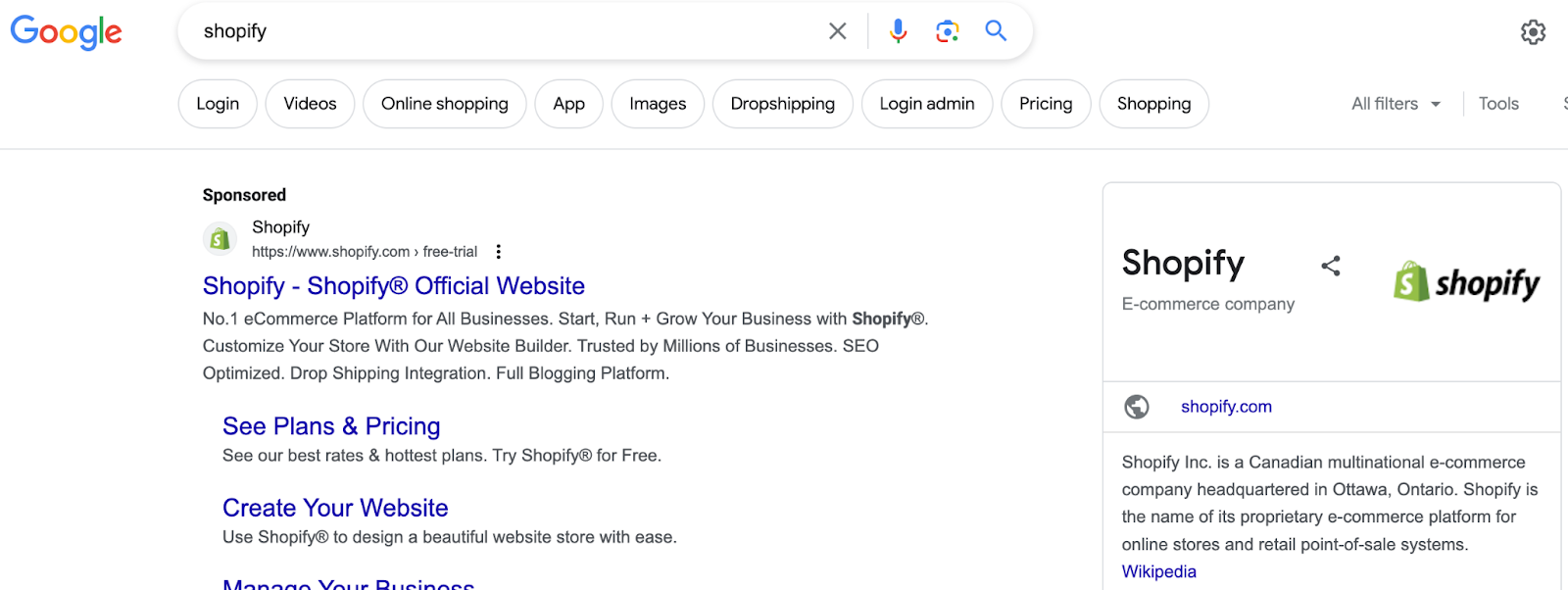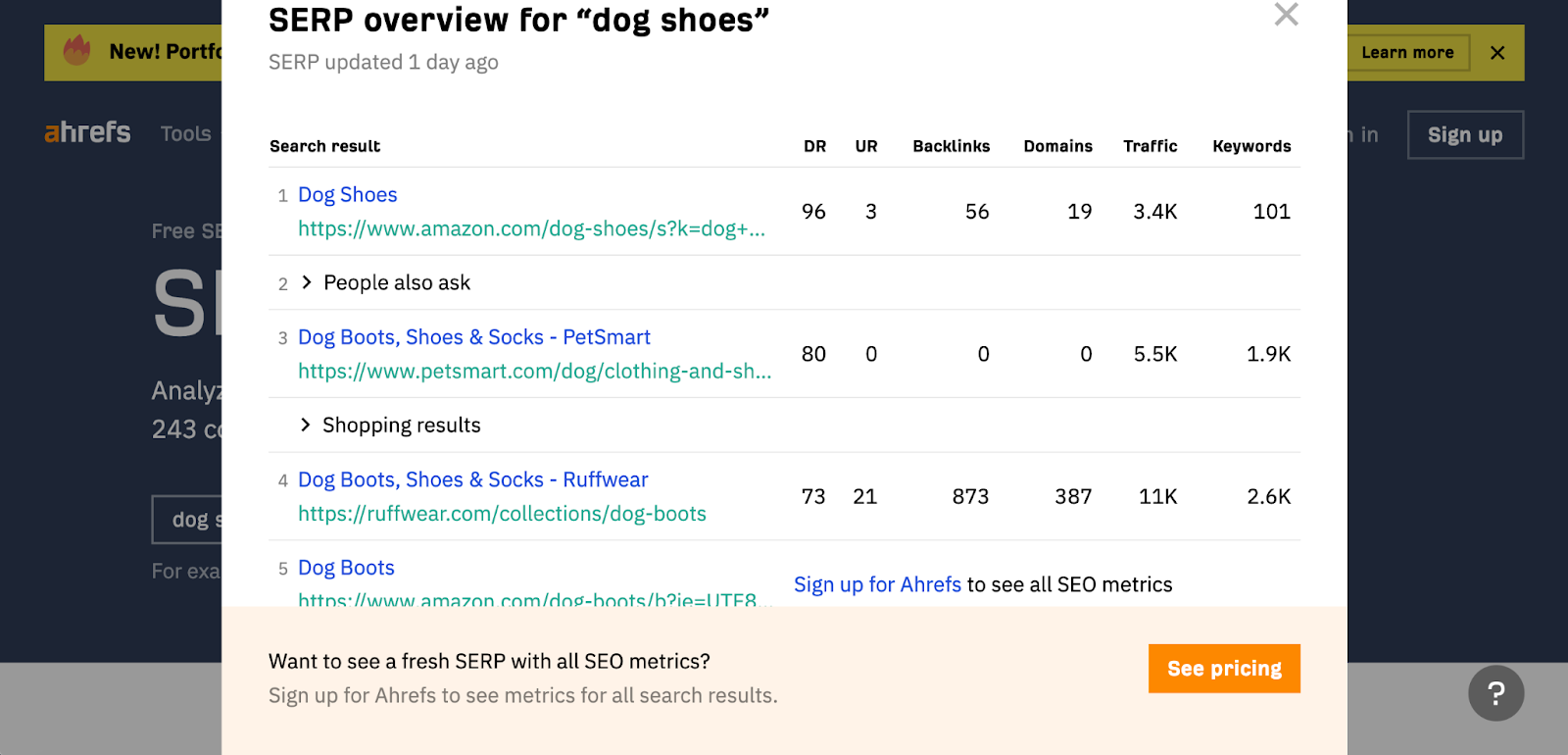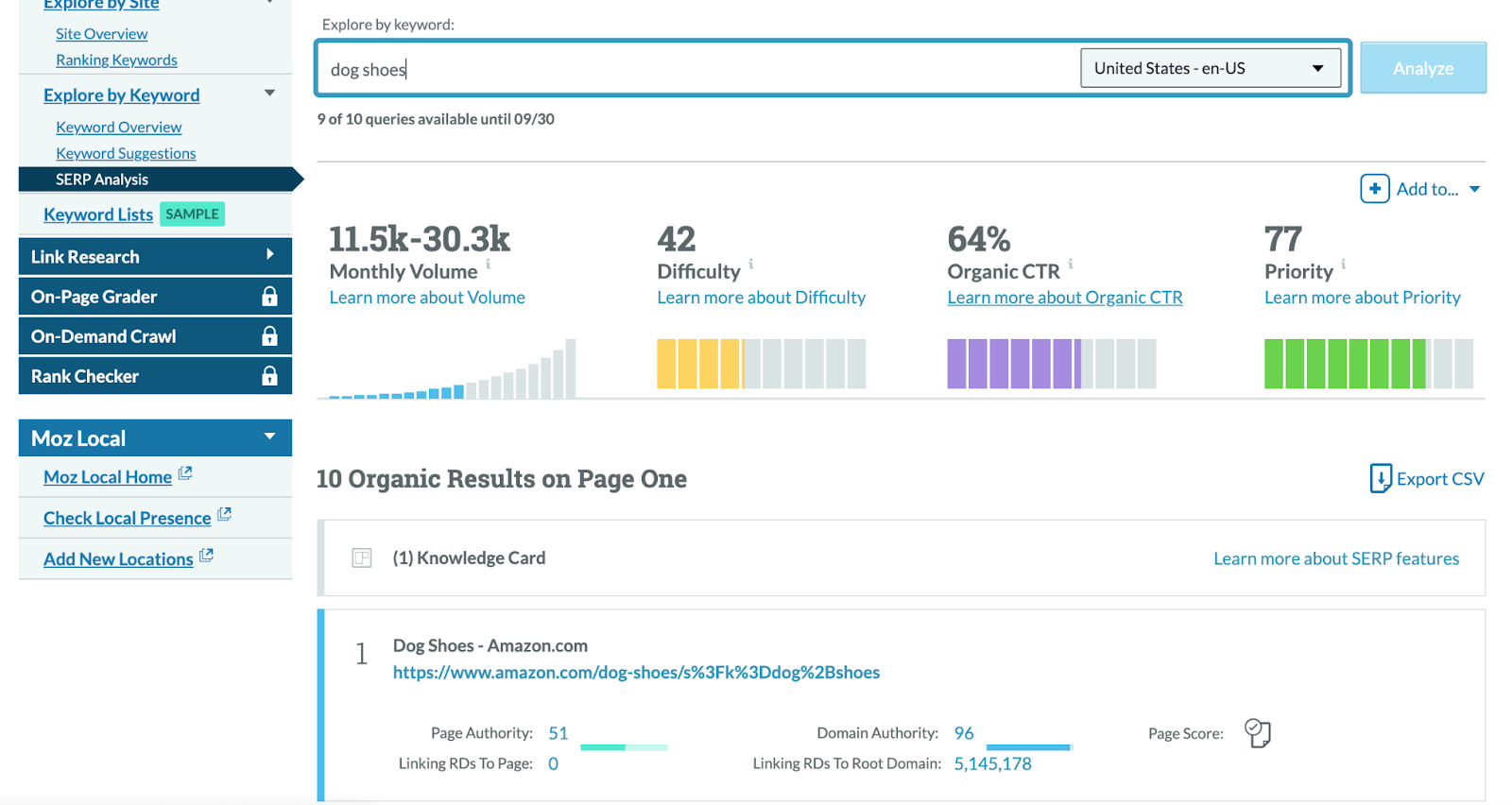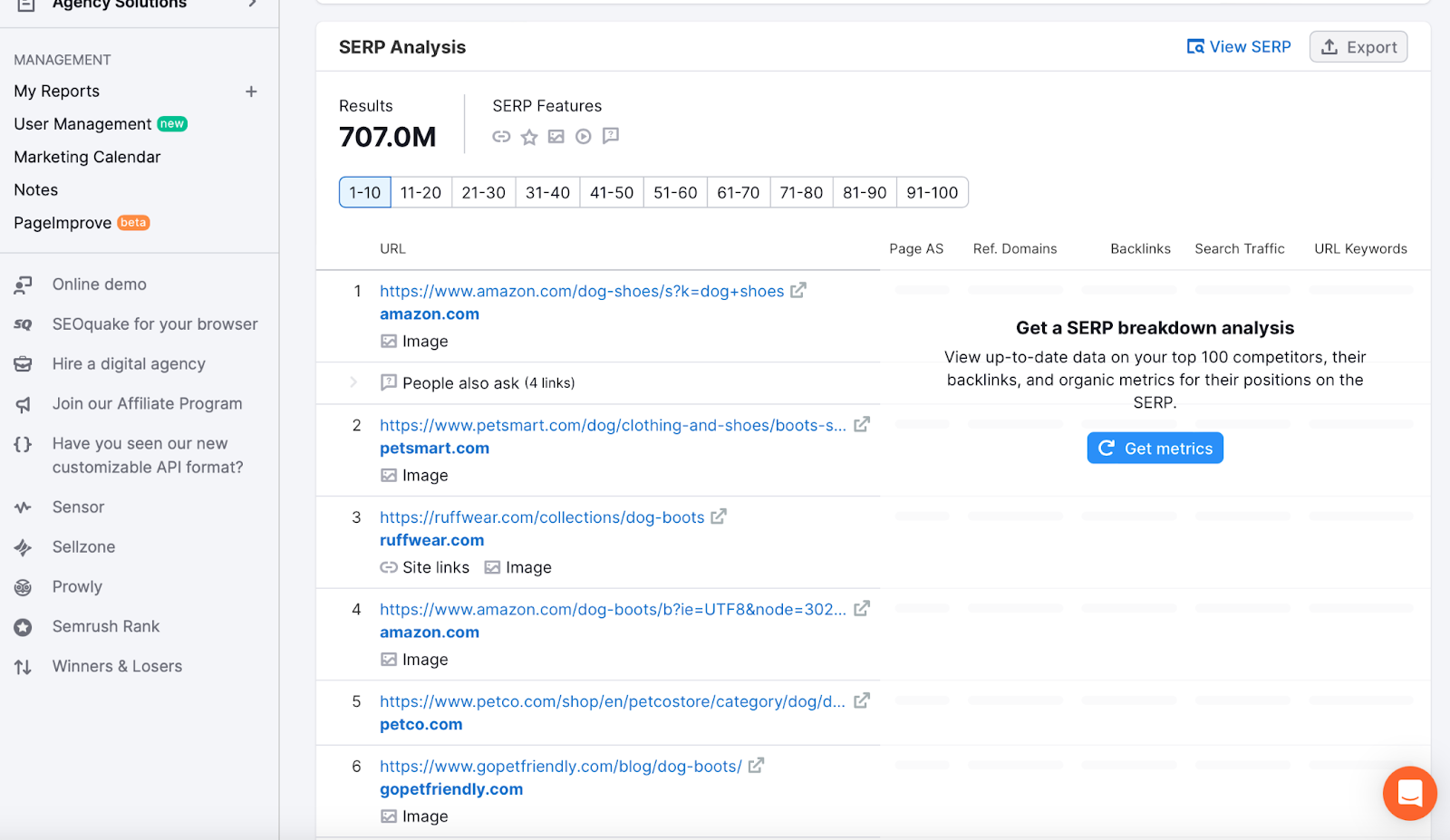So, you’ve decided to invest in search engine optimization to ensure customers can find your content. Before going on a content-creation spree targeting every keyword in your niche, hit pause and conduct a quick SERP analysis.
A search engine results page analysis only takes a few minutes per keyword and can save you time and money. It’s the best way to determine which queries are a good fit for your brand and which aren’t worth the effort.
What is a SERP?
SERP stands for “search engine results page.” It’s the page of links that appears when you enter a query into a search engine like Google or Bing. The SERP looks different depending on the search engine, your device (mobile or desktop), and your query type. With more than 80% of the global market share, Google sets the standard for how SERPs function.
Google SERP features
At its most basic, a SERP contains text links to both paid and organic (nonpaid) results. However, as Google—and the internet—has evolved, SERPs have evolved to include more of what Google calls “rich results.” According to Google, these “go beyond the standard blue link. Rich results can include carousels, images, or other non-textual elements.”
Here are a few different types of SERP features you might see:
Featured snippet
Google uses featured snippets to answer common questions directly on the SERP—no need to click on a result. This might consist of a definition or answer pulled from a site that Google’s algorithm has deemed authoritative. For example, you’ll find a featured snippet at the top of the Google SERP for the query “featured snippet.”

Knowledge panel
If your query involves what Google calls an entity (a person, place, organization, or thing), you might see a knowledge panel instead of a featured snippet. According to Google, knowledge panels “are meant to help you get a quick snapshot of information on a topic based on Google’s understanding of available content on the web.” If you Google “Shopify,” you’ll see a knowledge panel (with information from Wikipedia) in the top right corner of the SERP.

Business profile
If you search for a local business, you may see a business profile in the upper right corner of the SERP, where a knowledge panel would typically appear. A business profile typically includes contact information, a small map, business hours, star ratings, reviews, and photos. The Google SERP for the search term “Dandelion Chocolate factory” features a business profile in the upper right corner.

People also ask
Depending on your query, you might see a few questions related to your search under the heading “People also ask” (PAA). If you click on the arrow to the right of the question, you get a brief answer in the form of a featured snippet, with a link to the source material at the bottom of the answer. The Google SERP for the query “SERP” has a “People also ask” section below the first organic result and a knowledge panel in the upper right corner.

What is SERP analysis?
SERP analysis is the process of identifying key elements of the search engine results page for a particular query. This is a crucial step in search engine optimization (SEO), ensuring your web pages are easy to find on search engines like Google.
Following SEO best practices, conduct SERP analysis after keyword research and before SEO content writing. Keyword research involves identifying queries relevant to your business. In a SERP analysis, you look at the current SERP for each target keyword to determine whether the keyword in question is a good fit and, if so, what elements your content should include to be competitive.
Checking the SERP helps you:
Assess search intent
Before targeting a particular keyword as part of your SEO strategy, ensure the user intent aligns with what you can offer. If your content can’t answer the user’s question, find out now rather than wasting resources on a keyword that’s not a good fit.
Find opportunities
Through the SERP analysis process, you may find new keywords to target. You might also discover the best way to share your content with searchers, such as through videos or by answering questions in the “People also ask” section.
Conduct competitor analysis
In SEO, competitor analysis, or competitive analysis, involves understanding the search landscape and your competitors to learn from what they’re doing well and identify areas where you can outperform them. One of the best ways to understand the competition is by conducting a simple SERP analysis.
Tools for SERP analysis
Technically, the only tool you need for SERP analysis is an internet-enabled device. But if you have a lot of queries to check, you might want a software program to do some of the work for you. SERP analysis tools can also show you link metrics that won’t appear on the SERP.
Another advantage of SERP tools is that the search results you see on your own are tied to your location. If your business is international, SERP tools allow you to quickly check differences between countries, without using a proxy server.
Here are some of the top tools available for conducting SERP analysis:
Ahrefs
Popular keyword research tool Ahrefs offers a free SERP checker that shows you link metrics for the first three organic search results, plus the locations of SERP features like “People also ask” and shopping carousels.
Ahrefs’ metrics include:
- Domain rating (DR). Estimates the site’s authority based on its backlinks.
- URL rating (UR). Estimates the particular URL’s authority.
- Backlinks. Shows how many links point toward the page.
- Domains. Shows the number of unique domains linking to the page.
- Traffic. Estimates the total organic traffic the URL receives.
- Keywords. Estimates how many different queries this page ranks for. (“Ranking” for a keyword means the URL in question shows up within the top 10 organic search results for a query.)

Moz
With a free Moz account, you can use the Keyword Explorer tool for up to 10 keywords a month.
The keyword overview shows a mini SERP analysis, which you can expand to see the top 10 organic search results, with a page authority score, domain authority score, number of links to the page, and links to the domain for all 10. It also gives you the option to export the data into a spreadsheet.

Semrush
The free version of Semrush’s SERP analysis shows you the top organic search results and the number, type, and location of SERP features. You need a paid account to see each link's authority score (AS), backlinks, traffic, and ranking keywords.

How to conduct SERP analysis
- Assess search intent
- Focus on format
- List the SERP features
- Check out the competition
- Identify opportunities
Follow this step-by-step guide to perform SERP analysis:
1. Assess search intent
Using an SEO tool to conduct SERP analysis might tell you whether a query is navigational, informational, commercial, or transactional.
- Navigational queries. Researchers are trying to navigate quickly to a URL (for example, by typing “Shopify” into the search bar).
- Informational queries. Searchers seek knowledge, like a definition or how-to guide.
- Commercial intent. Searchers want to learn more about a product.
- Transactional intent. Searchers are ready to buy a specific product.
You can easily find this information by looking at the top 10 organic search results and SERP features for a keyword and see which of these categories it falls into.
2. Focus on format
Once you’ve assessed the primary search intent, identify the content format. Are most of the top 10 organic results blog posts, videos, product pages, how-to guides, or product reviews? Look at the page titles for words like “how to” and “best [product name]” to quickly understand what type of content is most relevant for this keyword.
3. List the SERP features
As SERPs increasingly include rich results, the best way for someone to find your content may be through a featured snippet or by answering the “People also ask” questions. Using an SEO tool can show you how many rich results are on the SERP. If not, simply write down the different SERP features, including the specific “People also ask” questions.
4. Check out the competition
After scanning the SERP, click on at least the first three organic search results to understand the competition. Note if the source is authoritative, pay special attention to what these search results have in common, including words in the page title and the number of headings and images.
Content-wise, is there something all the top articles include that you should, too? Or can you add something the competition is missing to help your content stand out?
5. Identify opportunities
Once you’ve visited the top organic search results, ask yourself: Can you create content on this topic that is comprehensive (covers everything in the top results) and adds something new to the conversation (isn’t just repeating other sources)? Can you provide answers to common “People also ask” questions?
For example, is there crucial context or information missing from other results? Does your brand have access to unique authority or expertise in this area? If the answer to any of these questions is yes, you’ve identified areas of opportunity that can help your content outrank competitors and reach one of the coveted top 10 positions on the SERP.
Use structured data to indicate how Google should display your content. Structured data requires some back-end work on your site, but it’s necessary to classify information—like reviews, FAQs, and your business description—that search engines use to create rich snippets in search results. Use Schema.org to format structured data for your pages.
SERP analysis FAQ
What affects SERP ranking?
Google and other search engines use algorithms to rank websites on SERPs. Google launched in 1998 with the PageRank algorithm, which organized relevant results by the number and quality of backlinks. While backlinks still play a role in Google’s ranking algorithm, other factors include freshness (content age), relevancy, originality, and whether the on-page experience is user-friendly.
Can SERP analysis help with content strategy?
SERP analysis can help with content strategy by narrowing down which keywords to target and how best to target them. In a SERP analysis, you discover if the search intent matches what you can provide. You also get a better understanding of what your competition provides.
Is SERP analysis different for local SEO?
Yes, if you sell products locally, you’ll need to conduct SERP analysis specifically for local SEO. The SERP may look slightly different for local SEO as you target keywords like “[business] near me” with rich results, including business profiles and local packs with maps.
How often should you conduct SERP analysis?
Conduct a SERP analysis before you create content targeting a specific question or keyword. For example, you may conduct a quick SERP analysis as part of keyword research and a more in-depth SERP analysis before creating the content.





